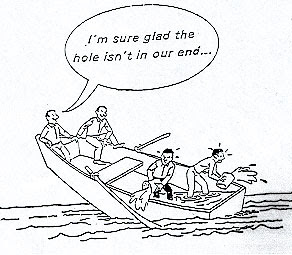Refresher’s Course
 “Nature loves a balance,but many times human decision makers act contrary to the balances and pay the price.” Peter Senge (*) says.
“Nature loves a balance,but many times human decision makers act contrary to the balances and pay the price.” Peter Senge (*) says.
So here’s to systems thinking. Ten laws to disolve our day-to-day illusions of linear cause-and-effect. Thank you for not only using them on dinner parties and PowerPoint presentations. Think of them when preparing your budgets, plans and soultions.
1. Today’s problems come from yesterday’s “solutions.”
2. The harder you push, the harder the system pushes back. (aka “compensating feedback.”)
3. Behavior grows better before it grows worse. Our “solutions” often make things look better only in the short run.
4. The easy way out usually leads back in.
5. The cure can be worse than the disease.
6. Faster is slower.
7. Cause and effect are not closely related in time.
8. Small changes can produce big results — but the areas of highest leverage are often the least obvious. It’s the difference between our “snapshot” views and the deeper, better understanding achieved through “process” thinking.
9. Dividing an elephant in half does not produce two small elephants. It produces a mess!
10. There is no blame. Senge asserts: “You and the cause of your problem are part of a single system. The cure lies in your relationship with your ‘enemy’.” This is wrapped inside an overarching reality, according to Senge, and that is: “There is no outside.”
__________________________________
(*) Peter Senge, The Fifth Discipline: The Art & Practice of The Learning Organization, ISBN: 0385517254


